The Application of Entropy in Motor Imagery Paradigms of Brain–Computer Interfaces
Abstract
1. Introduction
2. Materials and Methods
3. Result
3.1. Physical Significance and Calculation Methods of Entropy
3.2. Application of Entropy in MI
3.2.1. Entropy for Feature Extraction
3.2.2. Entropy for Optimizing Classification Algorithms
3.2.3. Multiple Entropy Fusion Classification
3.3. Number of Research of Entropy Features in MI-BCI
3.4. Accuracy of Entropy Features in MI-BCI
3.5. Entropy Type in MI-BCI
3.6. Selection of Datasets
4. Discussion
4.1. Comparison with Other Methods
4.2. Frequently Used Entropy Features in MI-BCI
4.3. Single- or Multiple-Entropy Features in MI-BCI
4.4. Application Scenarios of Entropy Features in MI-BCI
5. Conclusions
6. Limitation
Funding
Conflicts of Interest
Appendix A. Entropy Calculation Method
- Shannon entropy [17]
- 3.
- Singular spectrum entropy [22]
- 6.
- Sample entropy [26]
- 9.
- Transfer entropy [31]
- 11.
- Spectral entropy [35]
- 12.
- Wavelet entropy [36]
Appendix B. Research Statistical Table
| Years | Authors | Entropy Type | Classifier Type | Dataset * | Accuracy |
|---|---|---|---|---|---|
| 2023 | [58] | Differential entropy | GBDT | 0 | 96.96 |
| 2023 | [59] | Wavelet entropy | RF | 0 | 99.26 |
| 2023 | [60] | Spectral entropy | SVM | 0 | 84.19 |
| 2023 | [61] | Shannon entropy | DRN | 0 | 91.6 |
| 2023 | [62] | Wavelet entropy | SVM | 0 | 97 |
| 2023 | [63] | Shannon entropy, Renyi entropy, Sample entropy, Permutation entropy, Approximate entropy | NB, SVM, RF, KNN | 0 | 97.83 |
| 2023 | [30] | Fuzzy entropy | LDA | 0 | 92.14 |
| 2023 | [35] | Spectral entropy | LDA | 1 | / |
| 2023 | [64] | Renyi entropy, Shannon entropy | LDA | 0 | 99.87 |
| 2023 | [17] | Shannon entropy | ELM | 0 | 99.48 |
| 2023 | [65] | Tsallis Entropy, Dispersion Entropy, Shannon entropy | RF, KNN | 0 | 74.48 |
| 2023 | [49] | Cross entropy | CNN | 0 | 97.61 |
| 2022 | [66] | Transfer entropy | CNN-LSTM | 1 | 97.21 |
| 2022 | [40] | Permutation entropy | Decision Tree, LDA, Naive Bayes, SVM, KNN, ECPA | 1 | 91.15 |
| 2022 | [67] | Sample entropy | BP network | 0 | 93 |
| 2022 | [19] | Power spectral entropy | SVM | 0 | 85.24 |
| 2022 | [44] | Sample entropy | SVM | 1 | 79.51 |
| 2022 | [68] | Approximate entropy | XGBO | 0 | 94.44 |
| 2022 | [69] | Spectral entropy | LDA | 0 | 98.67 |
| 2022 | [70] | Spectral entropy | Decision Tree | 0 | 98.71 |
| 2022 | [56] | Approximate entropy, Sample entropy, Fuzzy entropy, Multiscale entropy | SVM | 0 | 97.88 |
| 2022 | [71] | Sample entropy | SVM | 1 | 93.89 |
| 2022 | [57] | Rhythm entropy | CNNs | 1 | 82.81 |
| 2022 | [72] | Transfer entropy | LDA | 1 | 92.1 |
| 2022 | [73] | Shannon entropy, Correlation entropy, Conditional entropy | Ego-CNNs | 0 | 93.4 |
| 2022 | [74] | Rayleigh entropy | SLDA | 0 | 96.5 |
| 2022 | [41] | Shannon entropy | SVM | 0 | 85 |
| 2022 | [75] | Information entropy | MSTL-MCF | 0 | 70.86 |
| 2022 | [76] | Shannon entropy | 3-D-CNN | 0 | 87.15 |
| 2022 | [46] | Shannon entropy | LRC | 0 | 95.42 |
| 2021 | [77] | Fuzzy entropy | SVM | 1 | 80.56 |
| 2021 | [78] | Sample entropy | / | 1 | / |
| 2021 | [79] | Sample entropy | SNN | 1 | 89.9 |
| 2021 | [45] | Permutation entropy, Weighted permutation entropy | SVM | 0 | 91.1 |
| 2021 | [80] | Renyi entropy | SVM | 0 | 31.14 |
| 2021 | [81] | Sample entropy | / | 1 | / |
| 2021 | [50] | Sample entropy, Permutation entropy | BiLSTM | 1 | 89 |
| 2021 | [82] | Sample entropy, Permutation entropy | CNN | 0 | / |
| 2021 | [83] | Shannon entropy | LDA | 0 | 99.8 |
| 2021 | [84] | Cross entropy | CNN | 0 | 80.8 |
| 2021 | [85] | Multiscale entropy | FLDA | 2 | 85.89 |
| 2021 | [86] | Renyi entropy | TE-base | 0 | 95 |
| 2021 | [51] | Sample entropy, Fuzzy entropy, Tsallis entropy, Improved Multiscale Permutation entropy, Multiscale Fuzzy Entropy, Refined Composite Multiscale Fuzzy entropy | RF | 1 | 99.66 |
| 2020 | [87] | Maximum entropy | SVM | 0 | 81.83 |
| 2020 | [88] | Sample entropy | ELM | 1 | 91 |
| 2020 | [89] | Approximate entropy, Fuzzy entropy | / | 0 | 97.4 |
| 2020 | [90] | Transfer entropy | / | 2 | / |
| 2020 | [47] | Cross entropy | CDAN | 0 | 95.3 |
| 2020 | [91] | Sample entropy | SVM | 1 | 99.5 |
| 2020 | [92] | Multiscale Fuzzy entropy | BP | 0 | 100 |
| 2020 | [93] | Spectral entropy | / | 1 | / |
| 2020 | [52] | Approximate entropy, Sample entropy, Shannon entropy, Logarithmic entropy, Permutation entropy, Renyi entropy, Tsallis entropy | FFMIC | 0 | 100 |
| 2020 | [94] | Cross entropy | FBSF-TSCNN | 0 | 82.4 |
| 2020 | [47] | Shannon entropy | CDAN | 0 | 94.3 |
| 2019 | [53] | Energy entropy, Fuzzy entropy, Multiscale entropy | KNN | 0 | 85.36 |
| 2019 | [42] | Wavelet-based average maximum entropy | / | 0 | 90.36 |
| 2019 | [95] | Shannon wavelet entropy, Logarithmic entropy | LS-SVM | 0 | 93 |
| 2019 | [55] | Improved refined composite multivariate multiscale fuzzy entropy | SVM | 0 | 99.86 |
| 2019 | [43] | Approximate entropy | SVM | 0 | 95.1 |
| 2019 | [96] | Approximate entropy | / | 1 | / |
| 2019 | [97] | Symbolic transfer entropy | LDA | 0 | 68.8 |
| 2019 | [98] | Minimum error entropy | / | 0 | / |
| 2019 | [48] | Shannon entropy | CDAN | 0 | Under 70 |
Appendix C. Journals Used in This Review
| Journals | Number |
|---|---|
| Entropy | 8 |
| Frontiers in Neuroscience | 6 |
| BIOMEDICAL SIGNAL PROCESSING AND CONTROL | 4 |
| IEEE Transactions on Neural Systems and Rehabilitation Engineering | 3 |
| Asian Journal of Control | 2 |
| BioMedical Engineering OnLine | 2 |
| Electronics | 2 |
| IEEE Journal of Translational Engineering in Health and Medicine | 2 |
| Journal of Neuroscience Methods | 2 |
| Sensors | 2 |
| Applied Sciences | 1 |
| arXiv | 1 |
| Behavioral Brain Research | 1 |
| Biocybernetics and Biomedical Engineering | 1 |
| Biosensors | 1 |
| Brain Sciences | 1 |
| Cognitive Neurodynamics | 1 |
| Computational Intelligence and Neuroscience | 1 |
| Computer Methods in Biomechanics and Biomedical Engineering | 1 |
| Computers in Biology and Medicine | 1 |
| Evolving Systems | 1 |
| Expert Systems with Applications | 1 |
| Frontiers in Aging Neuroscience | 1 |
| Frontiers in Human Neuroscience | 1 |
| Frontiers in Neuroinformatics | 1 |
| IEEE Access | 1 |
| IEEE Sensors Journal | 1 |
| IEEE Signal Processing Letters | 1 |
| IEEE Transactions on Computational Social Systems | 1 |
| IEEE Transactions on Neural Networks and Learning Systems | 1 |
| International Journal of Pattern Recognition and Artificial Intelligence | 1 |
| Journal of Neural Engineering | 1 |
| Mathematical Biosciences and Engineering | 1 |
| Multimedia Tools and Applications | 1 |
| Neuroscience Letters | 1 |
| Neuroscience Research | 1 |
| PLOS ONE | 1 |
| Power and Entropy | 1 |
| Signal | 1 |
| Wireless Communications and Mobile Computing | 1 |
References
- Liu, H.; Du, Y.; Peng, J. A review of brain-computer interface development. Electron. Sci. Technol. 2011, 24, 116–119. [Google Scholar]
- Wang, H.; Jia, J.; Sun, L. Application of motor imagery therapy in upper limb rehabilitation of stroke patients and research progress of its neural mechanism. Chin. J. Phys. Med. Rehabil. 2019, 41, 473–476. [Google Scholar]
- Tariq, M.; Trivailo, P.M.; Simic, M. Mu-Beta event-related (de)synchronization and EEG classification of left-right foot dorsiflexion kinaesthetic motor imagery for BCI. PLoS ONE 2020, 15, e0230184. [Google Scholar] [CrossRef] [PubMed]
- Wang, K.; Xu, M.; Wang, Y.; Zhang, S.; Chen, L.; Ming, D. Enhance decoding of pre-movement EEG patterns for brain–computer interfaces. J. Neural Eng. 2019, 17, 016033. [Google Scholar] [CrossRef]
- Zhang, L.; Wen, D.; Li, C.; Zhu, R. Ensemble classifier based on optimized extreme learning machine for motor imagery classification. J. Neural Eng. 2020, 17, 026004. [Google Scholar] [CrossRef]
- Wang, K.; Zhai, D.-H.; Xia, Y. Motor Imagination EEG Recognition Algorithm based on DWT, CSP and Extreme Learning Machine. In Proceedings of the 2019 Chinese Control Conference (CCC), Guangzhou, China, 27–30 July 2019; pp. 4590–4595. [Google Scholar] [CrossRef]
- Jin, Z.; Zhou, G.; Gao, D.; Zhang, Y. EEG classification using sparse Bayesian extreme learning machine for brain–computer interface. Neural Comput. Appl. 2018, 32, 6601–6609. [Google Scholar] [CrossRef]
- Ang, K.K.; Chin, Z.Y.; Wang, C.; Guan, C.; Zhang, H. Filter Bank Common Spatial Pattern Algorithm on BCI Competition IV Datasets 2a and 2b. Front. Neurosci. 2012, 6, 39. [Google Scholar] [CrossRef]
- Chen, C.-Y.; Wu, C.-W.; Lin, C.-T.; Chen, S.-A. A novel classification method for motor imagery based on Brain-Computer Interface. In Proceedings of the 2014 International Joint Conference on Neural Networks (IJCNN), Beijing, China, 6–11 July 2014; pp. 4099–4102. [Google Scholar] [CrossRef]
- Lotte, F.; Bougrain, L.; Cichocki, A.; Clerc, M.; Congedo, M.; Rakotomamonjy, A.; Yger, F. A review of classification algorithms for EEG-based brain–computer interfaces: A 10 year update. J. Neural Eng. 2018, 15, 031005. [Google Scholar] [CrossRef] [PubMed]
- Kevric, J.; Subasi, A. Comparison of signal decomposition methods in classification of EEG signals for motor-imagery BCI system. Biomed. Signal Process. Control 2017, 31, 398–406. [Google Scholar] [CrossRef]
- Park, S.; Ha, J.; Kim, D.-H.; Kim, L. Improving Motor Imagery-Based Brain-Computer Interface Performance Based on Sensory Stimulation Training: An Approach Focused on Poorly Performing Users. Front. Neurosci. 2021, 15, 732545. [Google Scholar] [CrossRef]
- Xu, P.; Wang, D. Research progress of information entropy in hydrology and water resources science. J. North China Univ. Water Resour. Hydropower (Nat. Sci. Ed.) 2017, 38, 3015–3028. [Google Scholar]
- Shannon, C.E. The mathematical theory of communication. 1963. M.D. Comput. Comput. Med. Pract. 1997, 14, 306–317. [Google Scholar]
- Jui, S.J.J.; Deo, R.C.; Barua, P.D.; Devi, A.; Soar, J.; Acharya, U.R. Application of Entropy for Automated Detection of Neurological Disorders With Electroencephalogram Signals: A Review of the Last Decade (2012–2022). IEEE Access 2023, 11, 71905–71924. [Google Scholar] [CrossRef]
- Yao, B.; Wu, C.; Zhang, X.; Yao, J.; Xue, J.; Zhao, Y.; Li, T.; Pu, J. The EEG-Based Fusion Entropy-Featured Identification of Isometric Contraction Forces Under the Same Action. Sensors 2024, 24, 2323. [Google Scholar] [CrossRef]
- Balmuri, K.R.; Madala, S.R.; Divakarachari, P.B.; de Prado, R.P.; Frnda, J. Enhanced grasshopper optimization algorithm with extreme learning machines for motor-imagery classification. Asian J. Control 2022, 25, 3015–3028. [Google Scholar] [CrossRef]
- Zhang, A.; Yang, B.; Huang, L. Feature Extraction of EEG Signals Using Power Spectral Entropy. In Proceedings of the 2008 International Conference on BioMedical Engineering and Informatics, Sanya, China, 27–30 May 2008; pp. 435–439. [Google Scholar]
- Wang, K.; Tian, F.; Xu, M.; Zhang, S.; Xu, L.; Ming, D. Resting-State EEG in Alpha Rhythm May Be Indicative of the Performance of Motor Imagery-Based Brain–Computer Interface. Entropy 2022, 24, 1556. [Google Scholar] [CrossRef] [PubMed]
- Wu, J.; Zhou, T.; Li, T. Detecting Epileptic Seizures in EEG Signals with Complementary Ensemble Empirical Mode Decomposition and Extreme Gradient Boosting. Entropy 2020, 22, 140. [Google Scholar] [CrossRef]
- Kojima, M.; Obuchi, S.; Mizuno, K.; Henmi, O.; Ikeda, N. Power Spectrum Entropy of Acceleration Time-series During Movement as an Indicator of Smoothness of Movement. J. Physiol. Anthr. 2008, 27, 193–200. [Google Scholar] [CrossRef] [PubMed]
- Krishnan, P.T.; Raj, A.N.J.; Balasubramanian, P.; Chen, Y. Schizophrenia detection using MultivariateEmpirical Mode Decomposition and entropy measures from multichannel EEG signal. Biocybern. Biomed. Eng. 2020, 40, 1124–1139. [Google Scholar] [CrossRef]
- Das, A.B.; Bhuiyan, M.I.H. Discrimination and classification of focal and non-focal EEG signals using entropy-based features in the EMD-DWT domain. Biomed. Signal Process. Control 2016, 29, 11–21. [Google Scholar] [CrossRef]
- Aydın, S.; Saraoğlu, H.M.; Kara, S. Log Energy Entropy-Based EEG Classification with Multilayer Neural Networks in Seizure. Ann. Biomed. Eng. 2009, 37, 2626–2630. [Google Scholar] [CrossRef]
- Delgado-Bonal, A.; Marshak, A. Approximate Entropy and Sample Entropy: A Comprehensive Tutorial. Entropy 2019, 21, 541. [Google Scholar] [CrossRef] [PubMed]
- Simons, S.; Espino, P.; Abásolo, D. Fuzzy Entropy Analysis of the Electroencephalogram in Patients with Alzheimer’s Disease: Is the Method Superior to Sample Entropy? Entropy 2018, 20, 21. [Google Scholar] [CrossRef] [PubMed]
- Zanin, M.; Zunino, L.; Rosso, O.A.; Papo, D. Permutation Entropy and Its Main Biomedical and Econophysics Applications: A Review. Entropy 2012, 14, 1553–1577. [Google Scholar] [CrossRef]
- Chen, W.; Wang, Z.; Xie, H.; Yu, W. Characterization of Surface EMG Signal Based on Fuzzy Entropy. IEEE Trans. Neural Syst. Rehabil. Eng. 2007, 15, 266–272. [Google Scholar] [CrossRef]
- Cao, Z.; Ding, W.; Wang, Y.-K.; Hussain, F.K.; Al-Jumaily, A.; Lin, C.-T. Effects of repetitive SSVEPs on EEG complexity using multiscale inherent fuzzy entropy. Neurocomputing 2019, 389, 198–206. [Google Scholar] [CrossRef]
- Li, L.; Chen, W.; Li, M. The application of hybrid feature based on local mean decomposition for motor imagery electroencephalogram signal classification. Asian J. Control 2023, 25, 3305–3317. [Google Scholar] [CrossRef]
- Schreiber, T. Measuring Information Transfer. Phys. Rev. Lett. 2000, 85, 461–464. [Google Scholar] [CrossRef] [PubMed]
- Renyi, A. On measures of entropy and information. In Proceedings of the Fourth Berkeley Symposium on Mathematical Statistics and Probability, Berkeley, CA, USA, 20 June–30 July 1960. [Google Scholar]
- Safara, F.; Ramaiah, A.R.A. RenyiBS: Renyi entropy basis selection from wavelet packet decomposition tree for phonocardiogram classification. J. Supercomput. 2020, 77, 3710–3726. [Google Scholar] [CrossRef]
- Xu, L.; Bai, L.; Jiang, X.; Tan, M.; Zhang, D.; Luo, B. Deep Rényi entropy graph kernel. Pattern Recognit. 2020, 111, 107668. [Google Scholar] [CrossRef]
- Choy, C.S.; Fang, Q.; Neville, K.; Ding, B.; Kumar, A.; Mahmoud, S.S.; Gu, X.; Fu, J.; Jelfs, B. Virtual reality and motor imagery for early post-stroke rehabilitation. Biomed. Eng. Online 2023, 22, 66. [Google Scholar] [CrossRef]
- Nikias, C.L.; Mendel, J.M. Signal processing with higher-order spectra. IEEE Signal Process. Mag. 1993, 10, 10–37. [Google Scholar] [CrossRef]
- Tsallis, C. Possible generalization of Boltzmann-Gibbs statistics. J. Stat. Phys. 1988, 52, 479–487. [Google Scholar] [CrossRef]
- Wu, D.; Jia, H.; Abualigah, L.; Xing, Z.; Zheng, R.; Wang, H.; Altalhi, M. Enhance Teaching-Learning-Based Optimization for Tsallis-Entropy-Based Feature Selection Classification Approach. Processes 2022, 10, 360. [Google Scholar] [CrossRef]
- Lv, Y.; Zhang, B.; Zou, G.; Yue, X.; Xu, Z.; Li, H. Domain Adaptation with Data Uncertainty Measure Based on Evidence Theory. Entropy 2022, 24, 966. [Google Scholar] [CrossRef]
- Yang, L.; Shi, T.; Lv, J.; Liu, Y.; Dai, Y.; Zou, L. A multi-feature fusion decoding study for unilateral upper-limb fine motor imagery. Math. Biosci. Eng. 2022, 20, 2482–2500. [Google Scholar] [CrossRef]
- Hou, Y.; Chen, T.; Lun, X.; Wang, F. A novel method for classification of multi-class motor imagery tasks based on feature fusion. Neurosci. Res. 2021, 176, 40–48. [Google Scholar] [CrossRef] [PubMed]
- Saha, S.; Hossain, S.; Ahmed, K.; Mostafa, R.; Hadjileontiadis, L.; Khandoker, A.; Baumert, M. Wavelet Entropy-Based Inter-subject Associative Cortical Source Localization for Sensorimotor BCI. Front. Neurosci. 2019, 13, 47. [Google Scholar] [CrossRef] [PubMed]
- Ji, N.; Ma, L.; Dong, H.; Zhang, X. EEG Signals Feature Extraction Based on DWT and EMD Combined with Approximate Entropy. Brain Sci. 2019, 9, 201. [Google Scholar] [CrossRef]
- Wang, J.; Chen, Y.-H.; Yang, J.; Sawan, M. Intelligent Classification Technique of Hand Motor Imagery Using EEG Beta Rebound Follow-Up Pattern. Biosensors 2022, 12, 384. [Google Scholar] [CrossRef]
- Sun, H.; Jin, J.; Kong, W.; Zuo, C.; Li, S.; Wang, X. Novel channel selection method based on position priori weighted permutation entropy and binary gravity search algorithm. Cogn. Neurodyn. 2020, 15, 141–156. [Google Scholar] [CrossRef] [PubMed]
- Khan, R.A.; Rashid, N.; Shahzaib, M.; Malik, U.F.; Arif, A.; Iqbal, J.; Saleem, M.; Khan, U.S.; Tiwana, M. A novel framework for classification of two-class motor imagery EEG signals using logistic regression classification algorithm. PLoS ONE 2023, 18, e0276133. [Google Scholar] [CrossRef]
- Tang, X.; Zhang, X. Conditional Adversarial Domain Adaptation Neural Network for Motor Imagery EEG Decoding. Entropy 2020, 22, 96. [Google Scholar] [CrossRef] [PubMed]
- Preciado-Grijalva, A.; Muthireddy, V.S.S.R. Evaluation of Deep Neural Network Domain Adaptation Techniques for Image Recognition. arXiv 2021. [Google Scholar] [CrossRef]
- Xie, Y.; Oniga, S. Classification of Motor Imagery EEG Signals Based on Data Augmentation and Convolutional Neural Networks. Sensors 2023, 23, 1932. [Google Scholar] [CrossRef] [PubMed]
- Li, H.; Fan, K.; Ma, J.; Wang, B.; Qiao, X.; Yan, Y.; Du, W.; Wanga, L. Massage Therapy’s Effectiveness on the Decoding EEG Rhythms of Left/Right Motor Imagery and Motion Execution in Patients With Skeletal Muscle Pain. IEEE J. Transl. Eng. Health Med. 2021, 9, 2100320. [Google Scholar] [CrossRef] [PubMed]
- Al-Qazzaz, N.K.; Alyasseri, Z.A.A.; Abdulkareem, K.H.; Ali, N.S.; Al-Mhiqani, M.N.; Guger, C. EEG feature fusion for motor imagery: A new robust framework towards stroke patients rehabilitation. Comput. Biol. Med. 2021, 137, 104799. [Google Scholar] [CrossRef]
- Khare, S.K.; Bajaj, V. A facile and flexible motor imagery classification using electroencephalogram signals. Comput. Methods Programs Biomed. 2020, 197, 105722. [Google Scholar] [CrossRef] [PubMed]
- Wu, L.; Wang, T.; Wang, Q.; Zhu, Q.; Chen, J. EEG Signal Processing Based on Multivariate Empirical Mode Decomposition and Common Spatial Pattern Hybrid Algorithm. Int. J. Pattern Recognit. Artif. Intell. 2019, 33, 1959030. [Google Scholar] [CrossRef]
- Chen, S.; Luo, Z.; Gan, H. An entropy fusion method for feature extraction of EEG. Neural Comput. Appl. 2016, 29, 857–863. [Google Scholar] [CrossRef]
- Li, M.; Wang, R.; Yang, J.; Duan, L. An Improved Refined Composite Multivariate Multiscale Fuzzy Entropy Method for MI-EEG Feature Extraction. Comput. Intell. Neurosci. 2019, 2019, 7529572. [Google Scholar] [CrossRef] [PubMed]
- Lv, Z.; Qiao, L.; Lv, H. Cognitive Computing for Brain–Computer Interface-Based Computational Social Digital Twins Systems. IEEE Trans. Comput. Soc. Syst. 2022, 9, 1635–1643. [Google Scholar] [CrossRef]
- Li, X.; Chen, P.; Yu, X.; Jiang, N. Analysis of the Relationship Between Motor Imagery and Age-Related Fatigue for CNN Classification of the EEG Data. Front. Aging Neurosci. 2022, 14, 909571. [Google Scholar] [CrossRef]
- Wang, Y.; Song, C.; Zhang, T.; Yao, Z.; Chang, Z.; Wang, D. Feature Extraction of Motor Imagery EEG via Discrete Wavelet Transform and Generalized Maximum Fuzzy Membership Difference Entropy: A Comparative Study. Electronics 2023, 12, 2207. [Google Scholar] [CrossRef]
- Wang, M.; Zhou, H.; Li, X.; Chen, S.; Gao, D.; Zhang, Y. Motor imagery classification method based on relative wavelet packet entropy brain network and improved lasso. Front. Neurosci. 2023, 17, 1113593. [Google Scholar] [CrossRef] [PubMed]
- Tiwari, A.; Chaturvedi, A. Automatic EEG channel selection for multiclass brain-computer interface classification using multiobjective improved firefly algorithm. Multimed. Tools Appl. 2022, 82, 5405–5433. [Google Scholar] [CrossRef]
- Kumar, T.R.; Mahalaxmi, U.; Mm, R.; Bhatt, D. Optimization enabled deep residual neural network for motor imagery EEG signal classification. Biomed. Signal Process. Control 2022, 80, 104317. [Google Scholar] [CrossRef]
- Phadikar, S.; Sinha, N.; Ghosh, R. Unsupervised feature extraction with autoencoders for EEG based multiclass motor imagery BCI. Expert Syst. Appl. 2022, 213, 118901. [Google Scholar] [CrossRef]
- Maher, A.; Qaisar, S.M.; Salankar, N.; Jiang, F.; Tadeusiewicz, R.; Pławiak, P.; El-Latif, A.A.A.; Hammad, M. Hybrid EEG-fNIRS brain-computer interface based on the non-linear features extraction and stacking ensemble learning. Biocybern. Biomed. Eng. 2023, 43, 463–475. [Google Scholar] [CrossRef]
- Batistić, L.; Lerga, J.; Stanković, I. Detection of motor imagery based on short-term entropy of time–frequency representations. Biomed. Eng. Online 2023, 22, 41. [Google Scholar] [CrossRef]
- Al-Qazzaz, N.K.; Aldoori, A.A.; Ali, S.H.B.M.; Ahmad, S.A.; Mohammed, A.K.; Mohyee, M.I. EEG Signal Complexity Measurements to Enhance BCI-Based Stroke Patients’ Rehabilitation. Sensors 2023, 23, 3889. [Google Scholar] [CrossRef] [PubMed]
- Zhang, X.; Li, H.; Dong, R.; Lu, Z.; Li, C. Electroencephalogram and surface electromyogram fusion-based precise detection of lower limb voluntary movement using convolution neural network-long short-term memory model. Front. Neurosci. 2022, 16, 954387. [Google Scholar] [CrossRef]
- Wang, X.; Lu, H.; Shen, X.; Ma, L.; Wang, Y. Prosthetic control system based on motor imagery. Comput. Methods Biomech. Biomed. Eng. 2021, 25, 764–771. [Google Scholar] [CrossRef]
- Thenmozhi, T.; Helen, R. Feature Selection Using Extreme Gradient Boosting Bayesian Optimization to upgrade the Classification Performance of Motor Imagery signals for BCI. J. Neurosci. Methods 2021, 366, 109425. [Google Scholar] [CrossRef]
- Roy, G.; Bhoi, A.K.; Das, S.; Bhaumik, S. Cross-correlated spectral entropy-based classification of EEG motor imagery signal for triggering lower limb exoskeleton. Signal Image Video Process. 2022, 16, 1831–1839. [Google Scholar] [CrossRef]
- Roy, G.; Bhoi, A.; Bhaumik, S. A Comparative Approach for MI-Based EEG Signals Classification Using Energy, Power and Entropy. IRBM 2021, 43, 434–446. [Google Scholar] [CrossRef]
- Lu, Z.; Zhang, X.; Li, H.; Zhang, T.; Gu, L.; Tao, Q. An asynchronous artifact-enhanced electroencephalogram based control paradigm assisted by slight facial expression. Front. Neurosci. 2022, 16, 892794. [Google Scholar] [CrossRef] [PubMed]
- King, J.-T.; John, A.R.; Wang, Y.-K.; Shih, C.-K.; Zhang, D.; Huang, K.-C.; Lin, C.-T. Brain Connectivity Changes During Bimanual and Rotated Motor Imagery. IEEE J. Transl. Eng. Health Med. 2022, 10, 2100408. [Google Scholar] [CrossRef]
- Jin, J.; Sun, H.; Daly, I.; Li, S.; Liu, C.; Wang, X.; Cichocki, A. A Novel Classification Framework Using the Graph Representations of Electroencephalogram for Motor Imagery Based Brain-Computer Interface. IEEE Trans. Neural Syst. Rehabil. Eng. 2021, 30, 20–29. [Google Scholar] [CrossRef] [PubMed]
- Jiang, L.; Liu, S.; Ma, Z.; Lei, W.; Chen, C. Regularized RKHS-Based Subspace Learning for Motor Imagery Classification. Entropy 2022, 24, 195. [Google Scholar] [CrossRef]
- Gao, C.; Sun, J. Motor Imagery Recognition Method Based on Multisource Transfer Learning and Multiclassifier Fusion. Wirel. Commun. Mob. Comput. 2022, 2022, 3893866. [Google Scholar] [CrossRef]
- Bang, J.-S.; Lee, M.-H.; Fazli, S.; Guan, C.; Lee, S.-W. Spatio-Spectral Feature Representation for Motor Imagery Classification Using Convolutional Neural Networks. IEEE Trans. Neural Netw. Learn. Syst. 2021, 33, 3038–3049. [Google Scholar] [CrossRef]
- Zhang, K.; Xu, G.; Du, C.; Liang, R.; Han, C.; Zheng, X.; Zhang, S.; Wang, J.; Tian, P.; Jia, Y. Enhancement of capability for motor imagery using vestibular imbalance stimulation during brain computer interface. J. Neural Eng. 2021, 18, 056064. [Google Scholar] [CrossRef] [PubMed]
- Yang, K.; Xi, X.; Wang, T.; Wang, J.; Kong, W.; Zhao, Y.-B.; Zhang, Q. Effects of transcranial direct current stimulation on brain network connectivity and complexity in motor imagery. Neurosci. Lett. 2021, 757, 135968. [Google Scholar] [CrossRef]
- Wang, P.; Zhou, Y.; Li, Z.; Huang, S.; Zhang, D. Neural Decoding of Chinese Sign Language With Machine Learning for Brain–Computer Interfaces. IEEE Trans. Neural Syst. Rehabil. Eng. 2021, 29, 2721–2732. [Google Scholar] [CrossRef]
- Mohammadi, M.; Mosavi, M.R. Comparison of two methods of removing EOG artifacts for use in a motor imagery-based brain computer interface. Evol. Syst. 2019, 12, 527–540. [Google Scholar] [CrossRef]
- Marcos-Martínez, D.; Martínez-Cagigal, V.; Santamaría-Vázquez, E.; Pérez-Velasco, S.; Hornero, R. Neurofeedback Training Based on Motor Imagery Strategies Increases EEG Complexity in Elderly Population. Entropy 2021, 23, 1574. [Google Scholar] [CrossRef] [PubMed]
- Kang, J.-H.; Youn, J.; Kim, S.-H.; Kim, J. Effects of Frontal Theta Rhythms in a Prior Resting State on the Subsequent Motor Imagery Brain-Computer Interface Performance. Front. Neurosci. 2021, 15, 663101. [Google Scholar] [CrossRef] [PubMed]
- Islam, K.; Ghorbanzadeh, P.; Rastegarnia, A. Probability mapping based artifact detection and removal from single-channel EEG signals for brain-computer interface applications. J. Neurosci. Methods 2021, 360, 109249. [Google Scholar] [CrossRef] [PubMed]
- Huang, X.; Zhou, N.; Choi, K.-S. A Generalizable and Discriminative Learning Method for Deep EEG-Based Motor Imagery Classification. Front. Neurosci. 2021, 15, 760979. [Google Scholar] [CrossRef] [PubMed]
- Hu, L.; Xie, J.; Pan, C.; Wu, X.; Hu, D. Multi-feature fusion method based on WOSF and MSE for four-class MI EEG identification. Biomed. Signal Process. Control 2021, 69, 102907. [Google Scholar] [CrossRef]
- Panche, I.D.L.P.; Álvarez-Meza, A.; Gómez, P.M.H.; Cárdenas-Peña, D.; Patiño, J.I.R.; Orozco-Gutiérrez, Á. Kernel-Based Phase Transfer Entropy with Enhanced Feature Relevance Analysis for Brain Computer Interfaces. Appl. Sci. 2021, 11, 6689. [Google Scholar] [CrossRef]
- Xu, C.; Sun, C.; Jiang, G.; Chen, X.; He, Q.; Xie, P. Two-level multi-domain feature extraction on sparse representation for motor imagery classification. Biomed. Signal Process. Control 2020, 62, 102160. [Google Scholar] [CrossRef]
- Wang, L.; Huang, W.; Yang, Z.; Hu, X.; Zhang, C. A method from offline analysis to online training for the brain-computer interface based on motor imagery and speech imagery. Biomed. Signal Process. Control 2020, 62, 102100. [Google Scholar] [CrossRef]
- Velasquez-Martinez, L.; Caicedo-Acosta, J.; Castellanos-Dominguez, G. Entropy-Based Estimation of Event-Related De/Synchronization in Motor Imagery Using Vector-Quantized Patterns. Entropy 2020, 22, 703. [Google Scholar] [CrossRef]
- Trendafilov, D.; Schmitz, G.; Hwang, T.-H.; Effenberg, A.O.; Polani, D. Tilting Together: An Information-Theoretic Characterization of Behavioral Roles in Rhythmic Dyadic Interaction. Front. Hum. Neurosci. 2020, 14, 185. [Google Scholar] [CrossRef] [PubMed]
- Shi, T.; Ren, L.; Cui, W. Feature Extraction of Brain–Computer Interface Electroencephalogram Based on Motor Imagery. IEEE Sens. J. 2019, 20, 11787–11794. [Google Scholar] [CrossRef]
- Li, M.; Wang, R.; Xu, D. An Improved Composite Multiscale Fuzzy Entropy for Feature Extraction of MI-EEG. Entropy 2020, 22, 1356. [Google Scholar] [CrossRef]
- Kwon, M.; Cho, H.; Won, K.; Ahn, M.; Jun, S.C. Use of Both Eyes-Open and Eyes-Closed Resting States May Yield a More Robust Predictor of Motor Imagery BCI Performance. Electronics 2020, 9, 690. [Google Scholar] [CrossRef]
- Chen, J.; Yu, Z.L.; Gu, Z.; Li, Y. Deep Temporal-Spatial Feature Learning for Motor Imagery-Based Brain–Computer Interfaces. IEEE Trans. Neural Syst. Rehabil. Eng. 2020, 28, 2356–2366. [Google Scholar] [CrossRef] [PubMed]
- Sadiq, M.T.; Yu, X.; Yuan, Z.; Zeming, F.; Rehman, A.U.; Ullah, I.; Li, G.; Xiao, G. Motor Imagery EEG Signals Decoding by Multivariate Empirical Wavelet Transform-Based Framework for Robust Brain–Computer Interfaces. IEEE Access 2019, 7, 171431–171451. [Google Scholar] [CrossRef]
- Ingram, T.G.; Solomon, J.P.; Westwood, D.A.; Boe, S.G. Movement related sensory feedback is not necessary for learning to execute a motor skill. Behav. Brain Res. 2018, 359, 135–142. [Google Scholar] [CrossRef] [PubMed]
- Panche, I.D.L.P.; Alvarez-Meza, A.M.; Orozco-Gutierrez, A. A Data-Driven Measure of Effective Connectivity Based on Renyi’s α-Entropy. Front. Neurosci. 2019, 13, 1277. [Google Scholar] [CrossRef]
- Chen, B.; Ma, R.; Yu, S.; Du, S.; Qin, J. Granger Causality Analysis Based on Quantized Minimum Error Entropy Criterion. IEEE Signal Process. Lett. 2019, 26, 347–351. [Google Scholar] [CrossRef]
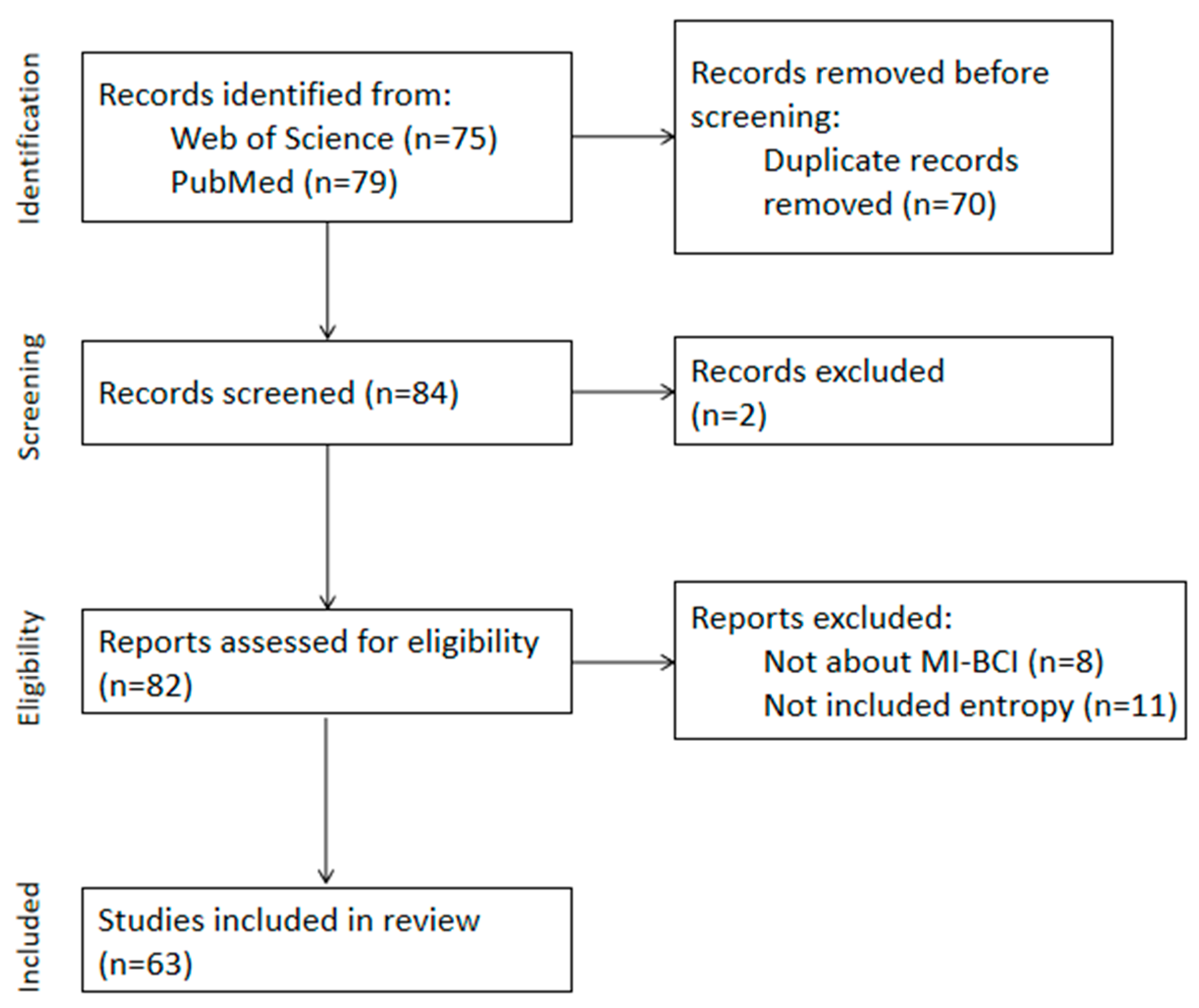
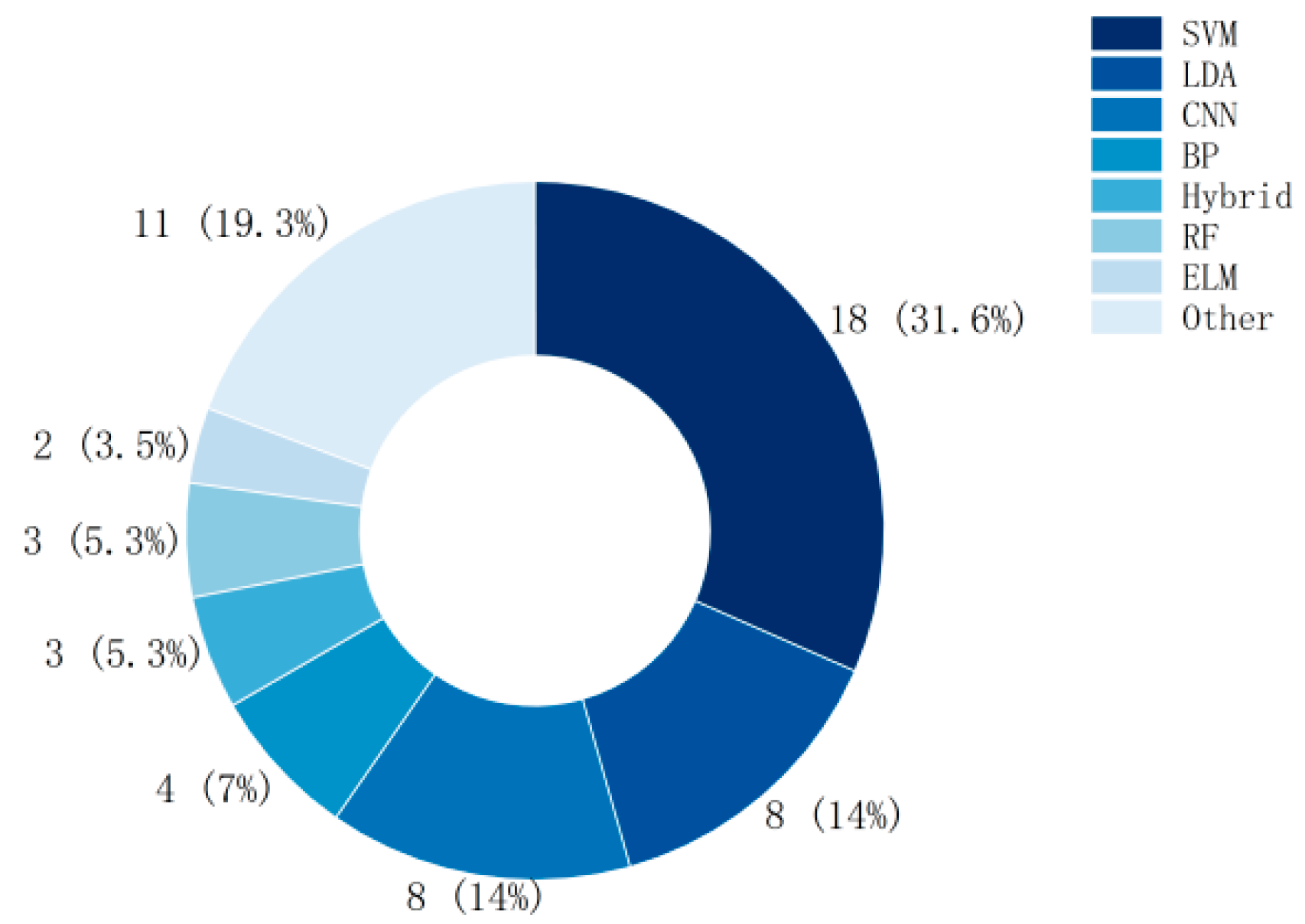
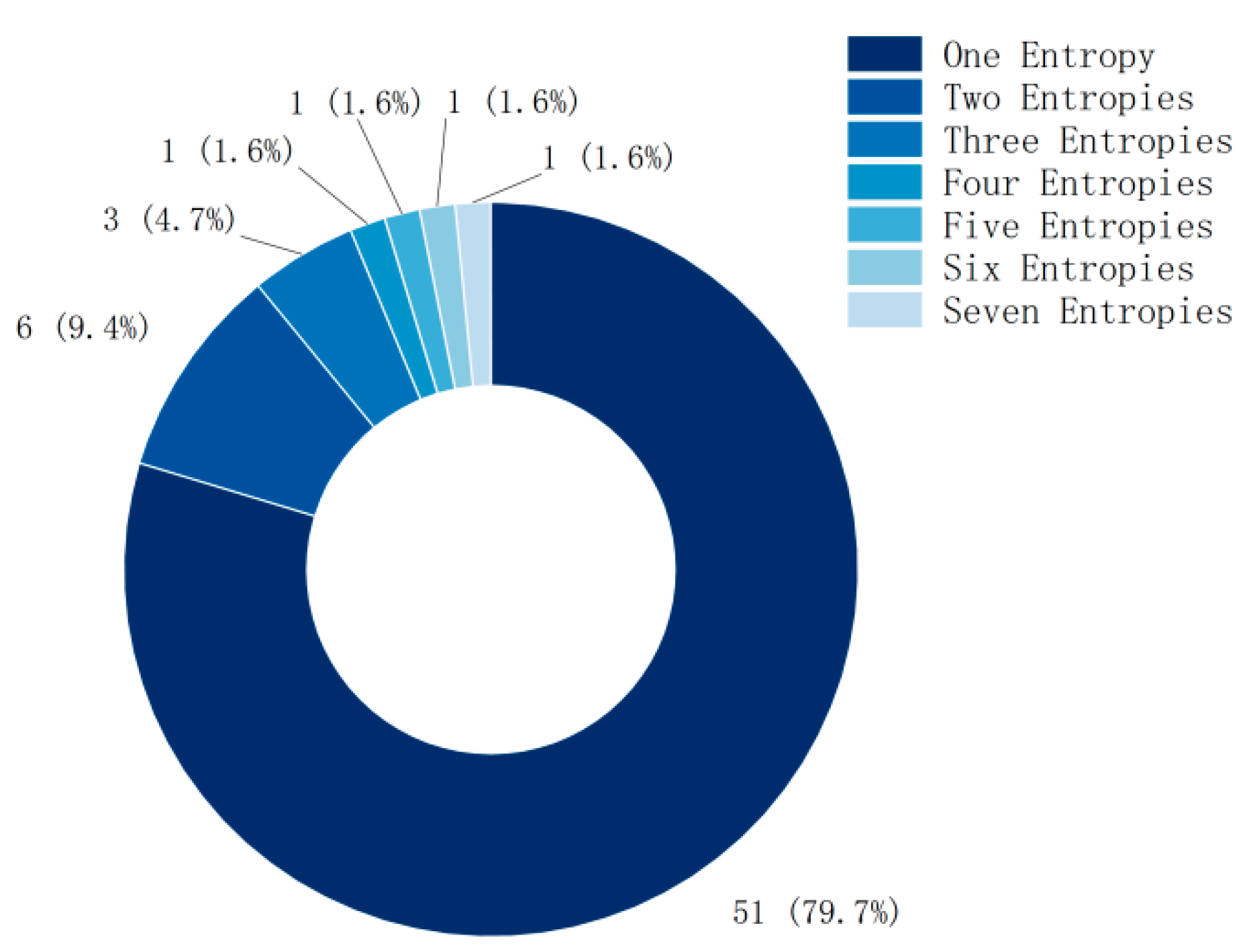
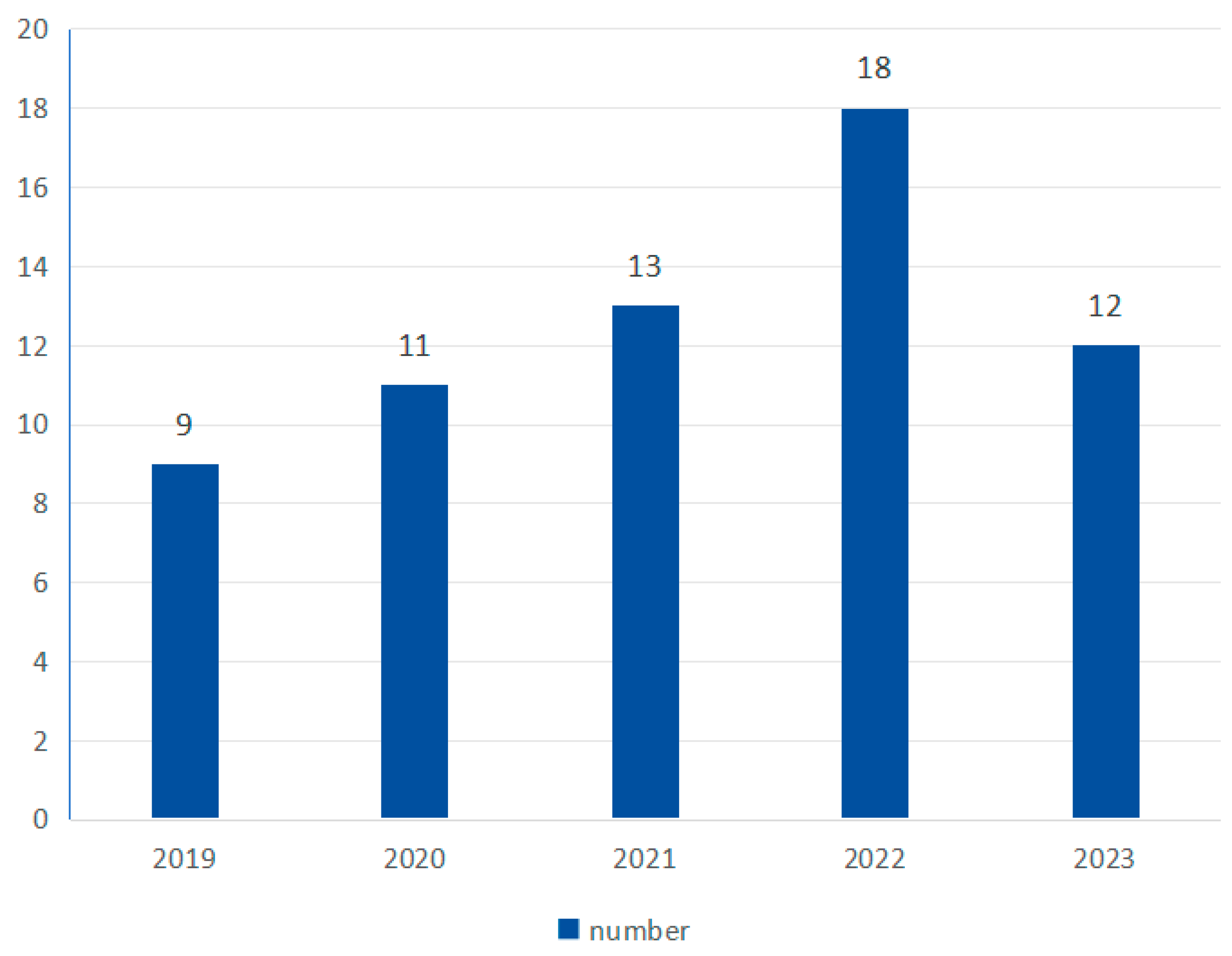

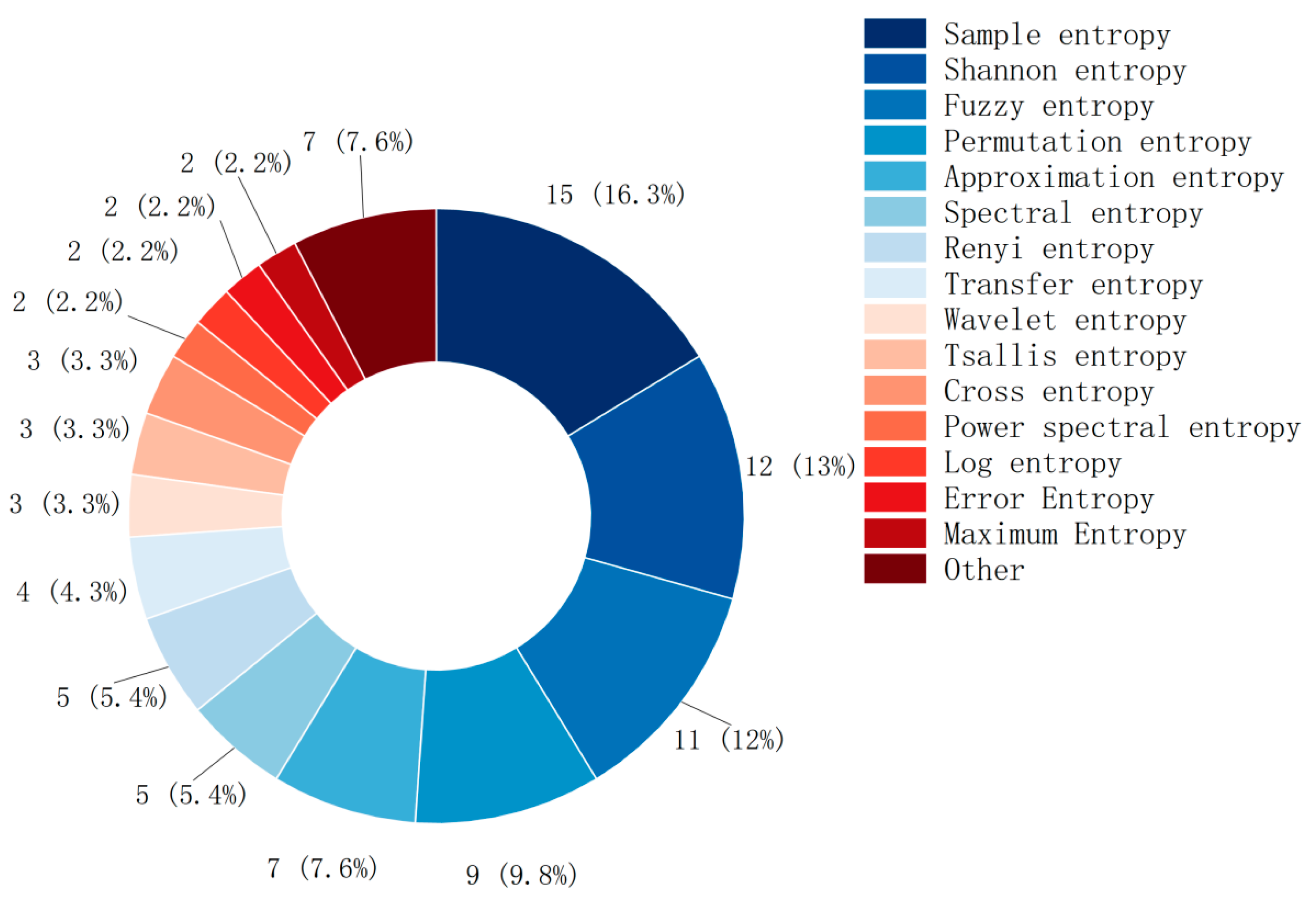
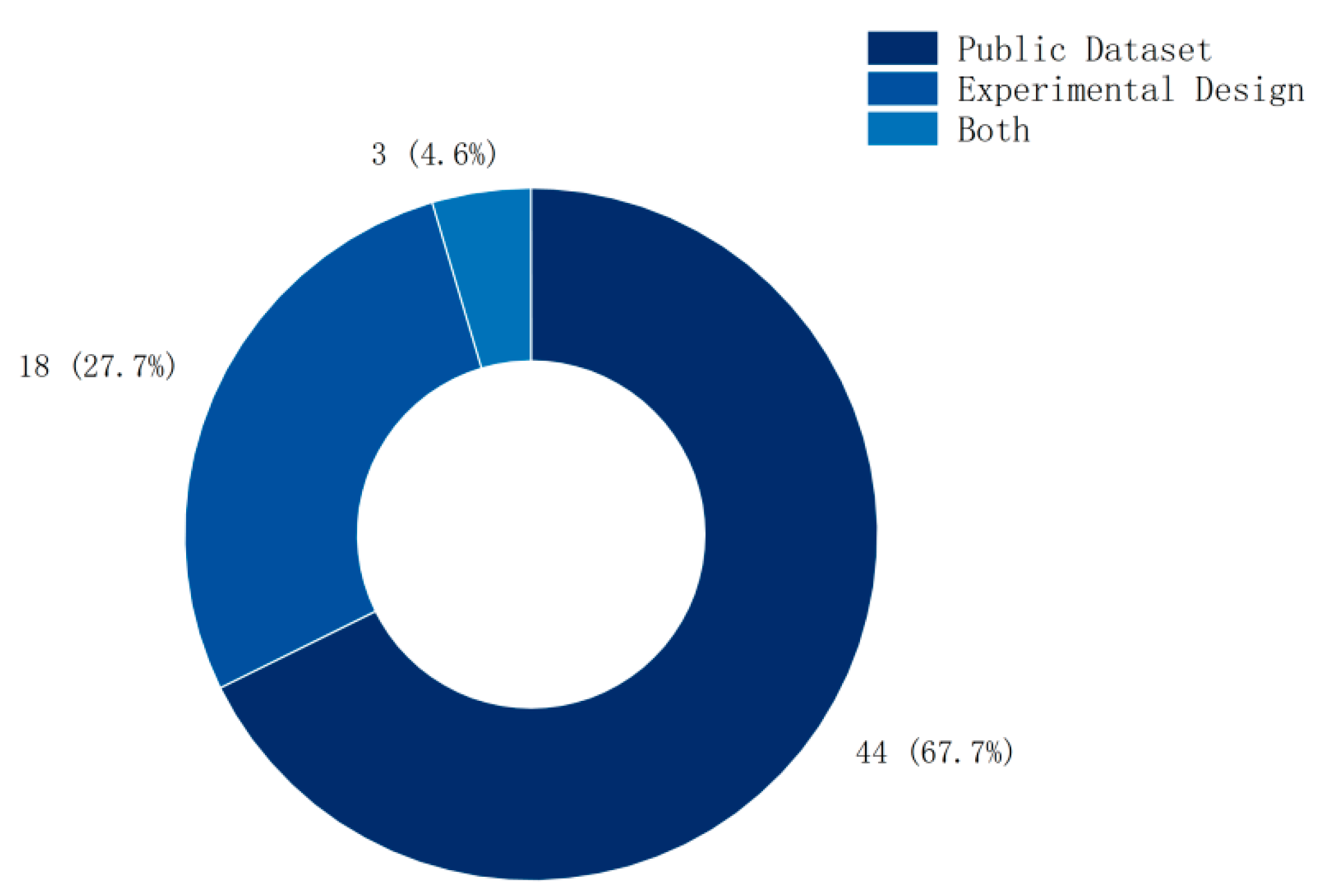
| Entropy | Function and Scope of Application | References |
|---|---|---|
| Shannon Entropy | The numerical value defined by Shannon to quantify information uncertainty or measure system complexity can be used to quantify EEG signals. | [17] |
| Power Spectral Entropy | It reflects the distribution of the power spectrum and belongs to the information entropy of the frequency domain. It is applicable to signals with certain frequency differences. The higher the power spectrum entropy value, the more complex and chaotic the signal is. | [18,19,20,21] |
| Singular Spectral Entropy | The complexity of the data is measured by analyzing the variance distribution of the eigenvectors in the singular value decomposition; higher entropy values indicate a more uniform and complex distribution. | [22] |
| Log Energy Entropy | It is able to describe the complexity of EEG sub-bands and help successfully classify EEG data by quantifying the variability of signal energy distribution in different frequency bands. | [23,24] |
| Approximate Entropy | Used to quantify the regularity of EEG time series, and is more suitable for signals with more random components. In general, approximate entropy measures correlation, persistence and regularity of data, that is, lower approximate entropy values indicate that a series is repetitive and predictable, and thus higher approximate entropy values indicate more uncertainty. | [15,25] |
| Sample Entropy | As an improved form of approximate entropy, it is used to evaluate the complexity of EEG signals. It reduces the deviation of approximate entropy and avoids the influence of signal length. | [26] |
| Fuzzy Entropy | It is a method for calculating sequence complexity proposed from the sample entropy theory. Fuzzy entropy uses an exponential function to fuzzify the similarity formula, overcoming the defects of sample entropy being sensitive to data length and discontinuous boundaries. Due to the monotonicity and continuity of the fuzzy exponential function, the fuzzy entropy changes smoothly and continuously with the change of parameters. This allows more detailed marginal information to be obtained. | [27,28,29,30] |
| Permutation Entropy | Assess the complexity of time series by comparing neighboring values, mapping to ordered patterns, identifying nonlinear signals, reducing problem space, and increasing robustness to noise. | [20,27] |
| Transfer Entropy | A model-free metric based on information theory can be used to calculate the amount of directed information transfer between two systems as a rigorous derivation of a Wiener causal measure. | [31] |
| Renyi Entropy | It is a generalization of Shannon entropy and represents the spectral complexity of a signal. | [32,33,34] |
| Spectral Entropy | The regularity of the time series corresponding to the uniformity of the power spectrum distribution is calculated using Shannon entropy and the power spectrum of the signal. | [35] |
| Wavelet Entropy | As a combination of wavelet decomposition and entropy, it aims to evaluate the chaos intensity of EEG signals. | [36] |
| Tsallis Entropy | It is a generalized entropy that describes the uncertainty or disorder of the microscopic state within the system, and can be used to deduce the importance of features in the EEG signal. The more uncertain the microscopic state of the system is, the larger the value of Tsallis entropy, indicating that the disorder or complexity of the system is higher. | [37,38,39] |
Disclaimer/Publisher’s Note: The statements, opinions and data contained in all publications are solely those of the individual author(s) and contributor(s) and not of MDPI and/or the editor(s). MDPI and/or the editor(s) disclaim responsibility for any injury to people or property resulting from any ideas, methods, instructions or products referred to in the content. |
© 2025 by the authors. Licensee MDPI, Basel, Switzerland. This article is an open access article distributed under the terms and conditions of the Creative Commons Attribution (CC BY) license (https://creativecommons.org/licenses/by/4.0/).
Share and Cite
Wu, C.; Yao, B.; Zhang, X.; Li, T.; Wang, J.; Pu, J. The Application of Entropy in Motor Imagery Paradigms of Brain–Computer Interfaces. Brain Sci. 2025, 15, 168. https://doi.org/10.3390/brainsci15020168
Wu C, Yao B, Zhang X, Li T, Wang J, Pu J. The Application of Entropy in Motor Imagery Paradigms of Brain–Computer Interfaces. Brain Sciences. 2025; 15(2):168. https://doi.org/10.3390/brainsci15020168
Chicago/Turabian StyleWu, Chengzhen, Bo Yao, Xin Zhang, Ting Li, Jinhai Wang, and Jiangbo Pu. 2025. "The Application of Entropy in Motor Imagery Paradigms of Brain–Computer Interfaces" Brain Sciences 15, no. 2: 168. https://doi.org/10.3390/brainsci15020168
APA StyleWu, C., Yao, B., Zhang, X., Li, T., Wang, J., & Pu, J. (2025). The Application of Entropy in Motor Imagery Paradigms of Brain–Computer Interfaces. Brain Sciences, 15(2), 168. https://doi.org/10.3390/brainsci15020168







